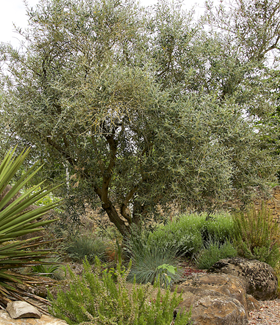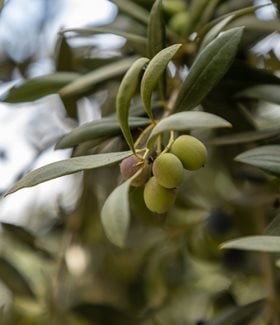GROWING OLIVE TREES - CARE & PLANTING
Learn the basics and get tips for pruning, harvesting, and overwintering olive trees indoors.Dating back to ancient Greece, olive trees are one of the oldest cultivated trees in the world, prized not only for their flavorful fruit but also for their many ornamental attributes. With their silvery foliage, gnarled trunks, and clusters of fragrant white flowers in spring, these distinctive trees are beautiful garden focal points in all seasons.
Although they grow best in a sunny Mediterranean climate, like that found along the California coast, it’s possible to grow olive trees almost anywhere if you protect them during harsh winters. You can even grow olive trees in containers and bring them indoors before freezing temperatures arrive. Dwarf varieties that grow no taller than 6 feet are ideal for that purpose.
And if the fruit isn’t important to you, there are many fruitless olive trees to choose from that offer all the beauty of an olive tree without the mess.
On this page: Basics | Planting | Care & Pruning | Growing Indoors | Varieties
- BASICS
- PLANTING OLIVE TREES
- OLIVE TREE CARE & PRUNING
- GROWING OLIVE TREES INDOORS
- OLIVE TREE VARIETIES
OLIVE TREE BASICS
Botanical name:
Olea europaea
Common names:
European olive tree, common olive tree
Plant type:
Evergreen fruit-bearing or fruitless tree
Zones:
Typically 8-11, although some cultivars are hardy down to zone 7. Mature trees that have had a chance to acclimate often have greater cold tolerance.
Climate requirements:
Olive trees grow best in regions with hot, dry summers and mild but cool winters. In order to bear fruit, they need a two-month dormancy period of cool weather when temperatures are ideally between 40° F to 50° F. However, colder winter temperatures (below 20° F) can damage or even kill a tree that is left unprotected.
Exposure:
Full sun
Size:
15 to 30 feet tall; 6 to 8 feet for dwarf varieties
Growth rate:
Slow, about 1 to 2 feet per year
Flowers:
Small creamy white and yellow flowers bloom in spring.
Foliage:
Feather-shaped, with a gray-green upper surface and lighter silvery white underside.
Fruit:
Most fruits (or drupes) start out green and turn a blackish-purple color when fully ripe, but they vary widely in size, shape, oil content, and flavor. Fruitless olive tree cultivars produce flowers but little to no fruit.
Lifespan:
Greater than 150 years, although trees living longer than 1,000 years are not uncommon.
PLANTING OLIVE TREES
When to plant:
The best time to plant is in spring, after the danger of frost is past. Newly planted trees are susceptible to frost damage during the first winter, so fall planting should only be done in areas where winter temperatures do not fall below 30° F. Avoid planting during the heat of the summer.
Where to plant:
Plant in full sun (8 or more hours daily) and away from paved areas to avoid stains from fallen fruit (unless growing a fruitless variety). Do not plant in low areas where standing water accumulates. Olive trees won’t survive when grown in waterlogged soil.
How to plant:
Dig a hole that is about the same diameter as the root ball and slightly shallower, so the top of the root ball is just above ground level. Avoid adding compost or organic matter to the planting hole. To achieve robust root growth, a young olive tree needs to adapt to its native soil.
Pollination:
Most olive trees are self-fertile, producing both male and female flowers on the same tree. However, you’ll often increase fruit yields by planting a tree of another variety nearby and allow them to cross pollinate.
OLIVE TREE CARE & PRUNING
Watering:
Olive trees are extremely drought tolerant once established, but for good flowering and fruit development, you should water them regularly throughout the growing season, especially if you live in a hot, dry climate.
- Spring and summer: Water newly planted trees deeply two or three times a week, preferably using a soaker hose or drip irrigation system. Established trees (5-7 years old) can be watered much less frequently, every few weeks, allowing the soil to dry out between waterings.
- Fall and winter: Cut back on watering. Depending on rainfall, no supplemental watering may be needed.
Soil:
Any well-drained soil is acceptable. Do not plant in heavy clay soils.
Amendments & Fertilizer:
Olive trees are not heavy feeders, and overly fertile soils can actually be a detriment to fruit production. However, trees grown in poor, mineral-deficient soils may benefit from regular feedings with a well-balanced fertilizer with a nitrogen content of at least 10 percent. To conserve soil moisture and inhibit weed growth, apply a layer of organic mulch around the tree, placing it a few inches away from the base.
Pruning:
Olive trees respond well to pruning, but the extent of pruning and the methods you use often depend on whether your primary goal is to boost fruit production or improve aesthetics. The Mediterranean Garden Society explains how to prune young trees to the desired shape, rejuvenate older trees, and selectively prune mature trees for better fruit development and easier harvesting. To keep your tree healthy, also remove dead or diseased branches and prune away any suckers that develop at the base of the tree.
Keep in mind that olive trees produce fruit on the previous year’s branches, so if fruit is desired, only prune lightly to open up the canopy and increase light penetration.
Harvesting olives:
You can harvest olives while they are still green or after they fully ripen in late fall, depending on how you plan to use them. Most freshly picked olives (even those that are fully ripe) are very bitter and will need to be cured before eating, either by brining or by sun drying.
Like apple trees, olive trees are alternate bearing, so don’t be surprised if your tree produces a bumper crop of olives one year and a poor crop the next. Young olive trees may not begin bearing optimal fruiting until 4-5 years, and will increase from there.
Diseases and pests:
Watch out for verticillium wilt, olive fruit flies, olive knot, and black scale. The olive fruit fly is the most serious pest of fruit-bearing trees and can completely damage an olive crop by laying its eggs just under the skin of the fruit. (See more information on olive fruit flies from University of California Agriculture.)
GROWING OLIVE TREES INDOORS
If you live in a cold climate where an olive tree won’t survive outdoors during the winter, growing your tree in a container that you can move indoors is a great alternative (although your tree is unlikely to bear fruit). Here are tips for growing an olive tree successfully indoors:
- Place it in a spot where it will receive at least 6 hours of sunlight a day, such as a south-facing window. Because olive trees are native to the Mediterranean, they can tolerate dry indoor air and usually won’t require additional humidity.
- Choose a dwarf olive tree variety that won’t grow taller than 6 feet. You can prune your tree, if necessary, to keep it shorter or even grow it as a bonsai.
- Plant your tree in a large container with good drainage, and use a potting soil mix that drains easily, such as a cactus potting soil.
- Apply a slow-release fertilizer twice a year, in spring and mid-summer with a slow-release fertilizer.
- Before moving your tree outdoors again in spring, wait until all danger of frost has passed and allow it to acclimate by gradually exposing it to more sunshine.
VARIETIES OF OLIVE TREES
MISSION OLIVE
(Olea europaea ‘Mission’)
Zones: 8-11
Height/Spread: 25 to 30 feet tall and wide
Named for the San Diego mission where it was first introduced, this popular shade tree and specimen plant, featuring a broad canopy of silvery foliage and a sculptural multi-trunk form. The fruit can be harvested when green or black and is popular for use in cold-pressed olive oil.
MANZANILLO OLIVE
(O. europaea ‘Manzanillo’)
Zones: 8-10
Height/Spread: 25 to 30 feet tall and wide
Like the Mission olive, this tall shade tree is common in California landscapes with its distinctive twisted trunk. The large, fleshy olives are the most common green table olives in the U.S. For smaller gardens, try ‘Haas Improved Manzanillo’, with arching branches on a more compact form (up to 15 feet).
MAJESTIC BEAUTY® FRUITLESS OLIVE
(O. europaea ‘Monher’)
Zones: 8-11
Height/Spread: 25 to 30 feet tall, up to 25 feet wide
A great patio plant or garden tree that does not produce messy fruit. Can also be planted near walkways, driveways, entryways and other high-traffic areas without concern for oily stains. Small, narrow, gray-green leaves give it an airy appearance.
SWAN HILL FRUITLESS OLIVE
(O. europaea ‘Swan Hill’)
Zones: 8-11
Height/Spread: 25 to 30 feet tall and wide
Another fruitless variety that flowers in spring, like a fruiting olive, but releases almost no pollen. Since the tree doesn’t put energy into making fruit, it produces a dense canopy of foliage and grows faster than most fruiting olive trees.
LITTLE OLLIE® DWARF OLIVE
(O. europaea ‘Montra’)
Zones: 8-11
Height/Spread: 6 to 8 feet tall and wide
Prized for its dense foliage and mounded shrub-like shape, this dwarf non-fruiting hybrid can be clipped and sheared to create formal hedges or topiaries or trained as a single-trunk specimen for planting in containers or along walkways. Exceptionally heat, drought, and salt tolerant.
ARBEQUINA OLIVE
(O. europaea ‘Arbequina’)
Zones: 7-11
Height/Spread: 15 to 20 feet tall, 8 to 12 feet wide
A beautiful Spanish variety from Catalonia, with a weeping form and compact habit. The fruits are small but fleshy and have a mild, fruity flavor and high oil content. One of the most cold-tolerant varieties.
ARBOSANA OLIVE
(O. europaea ‘Arbosana’)
Zones: 8-10
Height/Spread: 12 to 15 feet tall, 12 to 20 feet wide
Because of its small size and high yields, this semi-dwarf cultivar from Spain is a favorite among growers who want to reap large olive crops in limited garden space. One of the earliest to bear fruit, often a year or two after planting.
FRANTOIO OLIVE
(O. europaea ‘Frantoio’)
Zones: 8-11
Height/Spread: Up to 20 feet tall and wide
This elegant tree from Tuscany has been around for centuries and produces one of the most highly acclaimed olive oils in the world, characterized by its wonderfully fruity flavor and aroma. It’s also a beautiful landscape plant, featuring a broad, airy canopy of striking silvery-gray foliage.
RELATED:
Mediterranean Garden Design
Mediterranean Plants for Your Garden
Flowering Trees
Best Evergreen Trees for Residential Gardens








